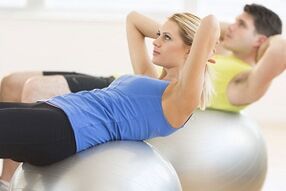
Osteochondrosis is a chronic vertebral disease in which degenerative and dystrophic changes occur in the vertebrae and the intervertebral discs.
On the most important
For a long time, the disease takes place asymptomatic, manifests itself with pain, altered sensitivity, the constraint of movements and other unpleasant phenomena, when the complications have already been formed in the vertebral column.
Important!The main complications of osteochondrosis include the projection of the intervertebral discs, the hernias of the som, the ankylosis of the spine, the violation of the rognes of the spinal nerves and the blood vessels.
Osteochondrosis brings a lot of suffering to the patient, considerably worsens the quality of life, often leads to the immobilization of the spine and disability.
How to treat osteochondrosis?
Depending on the level of damage to the spine, the prevalence of the dystrophic degenerative process, the severity of the disease and the presence of complications, the treatment of osteochondosis can be conservative or operational.
The method of processing osteochondrosis can only be discussed after an in -depth examination of the patient.
When you identify the first signs of osteochondrosis, you should consult a neuropathologist or a vertebrologist.
In the treatment of osteochondosis, a doctor of exercise therapy, a manual therapist, a physiotherapist and, if necessary, an orthopedist, a surgeon and a neurosurgeon.
Conservative treatment of osteochondrosis has an integrated approach - various methods of traditional and non -traditional medicine are used, such as:
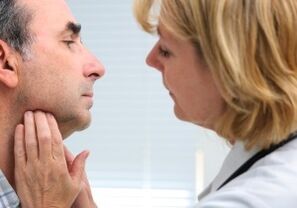
- drug therapy;
- Medical gymnastics and physical education;
- Isometric kinsotherapy;
- Manual therapy;
- reflexology;
- Massage and self-massage;
- physiotherapeutic methods;
- medical nutrition;
- Traditional medicine methods.
Drug treatment of osteochondrosis
Medicines used for osteochondrosis by type of action can be divided into these groups:
- Drugs to eliminate the inflammatory process in the spine, nerves and paravertebral tissues - non -steroidal anti -inflammatory drugs and glucocorticosteroids;
- Project to relieve pain - pain relievers and anesthetics;
- Preparations to relax spasmodic muscles - muscle relaxing;
- Drugs that improve nutrition of the cartilage tissue of intervertebral discs, and also protect it from the effects of negative factors - chondroprotective;
- Drugs that activate metabolism and restore normal blood flow in the spine of the spine - vitamins, antioxidants;
- Drugs that improve and restore the conductivity of impulses on the nerves - B vitamins;
- The preparations that relieve the swelling of the roots of vertebral nerves and paravertebral tissues are the diuretics.
Medicine of osteochondrosis therapy in the acute period aims to stop and relieve pain syndrome.To this end, the following drugs are used:

- analgesics;
- Non-steroidal anti-inflammatory drugs.The mechanism of action of these drugs lies in blocking the synthesis of prostaglandins, which trigger the inflammatory process and are responsible for the perception of pain.At the start of therapy, the path of injection of medication administration is used and, after a few days, they go to oral administration.The course of treatment is 7 to 10 days;
- Musorelaxing relieves reflex muscle spasm, thereby reducing pain.Medicines are taken inside for 2 to 3 weeks;
- Paravertebral blockade performed to eliminate pain.Such a blockage effectively relieves pain for several days;
- Glucocorticosteroid hormonal drugs are a means of severe artillery, have pronounced anti-inflammatory and analgesic effects, even when anti-inflammatory drugs and ineffective non-esteroidal anesthetics.Medicines are used in short courses to avoid side effects;
- Preparation for local use: ointments, gels, patches with irritating and distracting effects.Local drugs may include non-steroidal anti-inflammatory drugs and anesthetics.
During the period of osteochondrosis, treatment must be pathogenetic and catering.Medicines used when sagging symptoms of osteochondrosis:
- Chondroprotectors are a group of drugs, which include glucosamines and structural components of chondroitine sulfate from the cartilage tissue of the vertebrae and intervertebral discs.
- Antioxidants and drugs that improve microcirculation and metabolism.
- B Vitamins V.
- Calcium preparations.
The evolution of treatment during the period of remission of osteochondrosis with the above drugs is 2 to 3 weeks.
Medical gymnastics and physical education for osteochondrosis
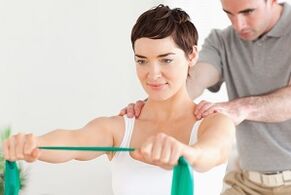
Therapeutic gymnastics and physical education for osteochondrosis are exercises developed on the basis of physical movements of the body which contribute to:
- reduction of clinical manifestations of osteochondrosis;
- slowdown in degenerative-dystrophic processes in the spine;
- restoration of the functions of the altered engine;
- Strengthen back, abdomen, buttocks and hip muscles;
- Relaxation of the stretched muscles of the back and neck;
- Expansion of intervertebral cracks and the release of pinched vertebral nerves;
- improve blood circulation;
- internal organ work.
So that therapeutic physical education and gymnastics bring the expected effect to adhere to the following rules:
- Osteochondosis exercises should be performed regularly.
- All movements must be smooth and slow.
- Breathing should be even.
- Follow the pulse frequency.
- In case of discomfort and pain in the muscles and the spine, it is necessary to reduce the amplitude and the intensity of the movements.
- Gymnastics and physical education can be done at any time of the day.
- To make medical gymnastics and physical education, choose comfortable clothes in natural fabric.
- Before you start engaging in therapeutic gymnastics and physical education, you need to consult the attending physician.
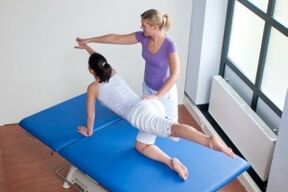
Isometric kinsotherapy is a modern direction of physiotherapy exercises, which consists in performing active and passive movements and respiratory gymnastics.
All kinsotherapy exercises are based on anatomical, physiological, biochemical and biomechanical aspects.
The main objective of kinsotherapy is to achieve the restoration of health, to preserve and improve it.
It is preferable to engage in physiotherapy and gymnastics in specialized hospitals and rehabilitation centers under the control of physiotherapy doctors, which specialize in complete rehabilitation and conservative treatment of osteochondosis.
However, there are also sets of exercises that can be done at home and even at work.
How does manual therapy with osteochondrosis?
Manual therapy is a method of treatment of osteochondosis, which consists of a manual effect dosed on the body in order to restore the correct configuration of the spine and improve its mobility.
There are contraindications for manual therapy:
- the presence of sequestration of the hernia of the intervertebral disc;
- intervertebral disc myelopathy;
- acute infectious diseases;
- mild and clever neoplasms;
- hypertension;
- alcohol poisoning;
- inflammatory joint diseases;
- postoperative period;
- The period of carrying a child.
During manipulation of manual therapy manipulation, complications such as ligament damage, muscles and vertebrae, the spine of hypermobility, the violation of intervertebral hernias, rib fractures and vertebrae processes, acute cerebrovascular disorders.
Therefore, it is important that manual therapy is carried out by a qualified specialist - a doctor in manual therapy, who has experience in this methodology.
Massage for osteochondrosis
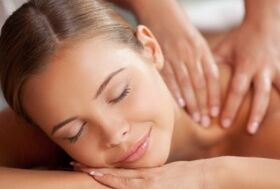
Using massage, you can relieve muscle spasms, improve microcirculation, innervation and metabolism in the spine, reduce swelling in the affected area, strengthen the back muscles and improve the patient's general condition.
Massage indications for osteochondrosis:
- Hypotrophy of back muscles;
- osteochondrosis at the stage of remission;
- back muscles;
- Pain in the area of the nerves of the spine of the roots;
- circulatory violation in the spine;
- Violation of mobility of the spine.
Contraindications to massage with osteochondrosis:
- Compression of the spinal cord with intervertebral hernias;
- decompensated disease of the cardiovascular system;
- Bacterial or fungal diseases of the skin;
- Diseases of the central nervous system (meningitis, encephalitis, cancer, stroke, injury, tuberculosis);
- mental illness in the exacerbation phase;
- respiratory diseases accompanied by respiratory failure;
- fever;
- diseases of the musculoskeletal system (clever and benign neoplasms, infectious diseases, injuries);
- Violation of blood coagulation.
Reflex therapy is an effect on various points of the body which are responsible for a particular organ.
Interesting!You can act on these points by needles, an electric shock, magnetic waves, etc.
Using this method, it is possible to improve blood intake to the affected areas of the spine and eliminate symptoms of the disease.
Physiotherapeutic methods for osteochondrosis

Types of physiotherapy:
- electrophoresis;
- magnetotherapy;
- ultrasound therapy;
- vibration massage;
- treatment with ultraviolet radiation;
- Balneotherapy and others.
The effects of physical treatment may be as follows:
- normalization of metabolism in affected areas;
- increase in bodily resistance;
- anesthesia;
- Improvement of microcirculation in the spine and paravertebral tissues;
- withdrawal of edema;
- reduction in the inflammatory process;
- Improved mobility of the spine.
Treatment of osteochondrosis at home
Most patients with osteochondosis believe that they can face the disease independently, taking pain relievers with handles.
Anti-inflammatory drugs and pain relievers only relieve the symptoms of osteochondrosis, but do not stop the pathological process in the spine.
Consequently, the treatment of house osteochondrosis is not only the use of pain relievers, but a full range of measures aimed at eliminating the cause of the disease, therapeutic gymnastics, traditional medicine methods, self-massage.
The elimination of the causes of osteochondrosis implies the following:
- Healthy food.In the daily diet, you should reduce the number of products that increase blood cholesterol - animal fats, chicken eggs, meat broths, pork.
- A healthy lifestyle.Limit the use of alcoholic drinks, coffee, strong tea.Get rid of bad habits, for example, smoking.
- A healthy sleep will help you provide accessories such as an orthopedic mattress and a pillow that creates optimal conditions for normal blood circulation during your sleep and your rest.
- Therapeutic gymnastics and physical education.
- Self-massage.At home, you can rub it yourself, pet and knead your back, neck and necklace.Self-massage will help get rid of headaches, dizzy, improve blood flow in affected areas of the spine, activate metabolism, relieve fatigue.
- The use of the applicator is special devices which are discs with points designed for the treatment of osteochondosis.
- Phytotherapy.You can take baths with decoctions of various herbs that will help turn off the pain in the back, for example, needles, chamomile, oak bark, spray, calamus, nut leaves, Valerian, lavender and others.Perfusions, dyes and decoctions to take mine leaves, celery root, garlic or saber root.
- Compens and applications from burdict leaves, raw potatoes with honey or ormotage wood, perfectly eliminate pain in the spine.
- The use of phyto -Paths (bags with herbs), which adjust the affected area of the spine at night - is the method of Chinese medicine.The biological substances of herbs penetrate through the skin and have a local - distracting and irritating effect.
- Using a massage bed or a massage chair.
- Wearing a Chanstz necklace with cervical osteochondosis, which eliminates pain, relieves the spasm of the neck muscles, increases the height of the intervertebral discs and releases the pinched nerves.

Important!There are many different methods of treatment of osteochondrosis at home, but do not forget the prescriptions of the attending physician.
All traditional and non -traditional treatment methods must be approved by it.
The regular and conscientious implementation of all the doctor's recommendations in its entirety, will slow down or completely stop the progression of osteochondrosis.


















